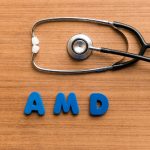Macular Degeneration
Medically Reviewed by: Dr. David Evans

Age-related Macular Degeneration (AMD)
As we grow older the likelihood of developing vision problems increases. One such age-related vision problem is macular degeneration, often referred to as AMD or ARMD. Characterized by deterioration of the macula — the small part of the retina responsible for focusing central vision in the eye — AMD is a common eye condition and the leading cause of blindness in people ages 65 and older.
Whereas the majority of the retina is responsible for general, peripheral vision, the macula provides for the highly detailed aspect of vision we rely on for tasks such as reading, and for seeing colors. Deterioration of this essential retinal tissue can drastically impact vision.
Types of Macular Degeneration
Macular degeneration comes in two distinct forms: neovascular (wet) and non-neovascular (dry).
Dry AMD represents the early stage of macular degeneration and is far and away the most common form of the disease, representing more than 85 percent of all diagnosed cases. (Not all cases of AMD progress.) As retinal pigment epithelial cells in the macula deteriorate with age, tiny yellowish dots called drusen begin to develop on the macula. This drusen can lead to damage of the macular region and macular degeneration. Vision loss associated with dry AMD tends to be slower, though it can progress to the more severe wet form of macular degeneration.
Wet AMD represents only 10-15 percent of AMD cases, but it is responsible for a staggering 90 percent of macular degeneration-related vision loss. It occurs when new blood vessels develop where they are not supposed to in the macula (hence neovascular). These blood vessels can leak blood and fluid into the retina, scarring the macula. Wet AMD has a small treatment window during which the damage can be minimized, though it progresses quickly and can lead to irreversible retinal cell death that can permanently impede central vision.
Signs and Symptoms of Macular Degeneration
Early stage macular degeneration may not affect your vision to the extent that it’s noticeable. Once the disease progresses and affects both eyes, the symptoms of AMD should be more pronounced. These symptoms — which vary depending on whether you have wet or dry AMD — can include:
- Fuzzy/distorted vision
- Sudden deterioration of vision
- Shadowed central vision (blind spots)
- Blurred distance and/or reading vision
- Diminished facial recognition
- Impaired color vision
- Changes in bright to low light vision
- Reduced contrast sensitivity
If you are over 65 and experiencing any of the aforementioned symptoms, schedule an appointment with an eye doctor as soon as possible.
Risk Factors for Macular Degeneration
In addition to your age, there are a number of other factors that can increase your risk of developing macular degeneration. These additional AMD risk factors include:
- Eye color: researchers have theorized that the extra pigment in darker eyes serves as added protection against retina tissue deterioration. If you have lighter eyes and a lighter skin tone, you may be at greater risk of AMD.
- Weight/lifestyle: Studies have linked obesity and inactivity with a faster progression of AMD. If you have macular degeneration and are overweight or lead an inactive, sedentary lifestyle, your risk for developing wet AMD can be more than double that of someone leading a healthier lifestyle.
- High blood pressure: Elevated blood pressure is associated with a number of health conditions and has recently been linked with the development of macular degeneration.
- Smoking: Studies have conclusively linked smoking with AMD. Even secondhand smoke can increase the likelihood of developing the condition.
Treatments for Macular Degeneration
Prevention is the best treatment for macular degeneration. A number of studies have been devoted to evaluating diet and its effect on the progression of AMD. There is some evidence that a diet rich in omega-3 fatty acids can help prevent AMD or at least slow its progression.
Regular eye screenings can help detect AMD risk factors and development before the symptoms become apparent. This is primarily done through a simple retinal exam using an Amsler grid, a very basic straight line grid with a small dot in the center for reference. If you have macular degeneration, the straight lines may appear wavy, and the reference dot may be blurred or darkened.
Currently, there are no FDA-approved treatments for dry macular degeneration. However, there are nutritional and dietary changes that can help slow its progression to wet macular degeneration. Antioxidants and zinc taken in combination has proven effective. In July 2010, the FDA also approved an implantable telescopic device that can be used to improve central vision.
For wet AMD, there are a number of FDA-approved drugs that can be administered to slow vision loss. Lucentis, Avastin, Eylea and Macugen are used in conjunction with photodynamic therapy (PDT) to slow the unnatural growth of blood vessels in the macula. Laser photocoagulation has also been used to target the blood vessels with laser energy to seal them off and prevent leaks.
To learn more about AMD treatments, schedule a consultation with an ophthalmologist.




